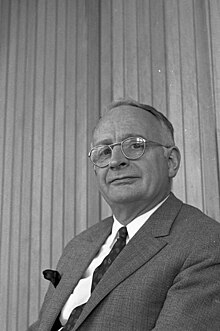Adriaan van Wijngaarden
Adriaan "Aad" van Wijngaarden (born November 2, 1916 in Rotterdam , † February 7, 1987 in Amstelveen ) was a Dutch computer scientist . He devoted himself particularly to the mathematical aspects of computer application , first in numerical analysis , later in the design of programming languages .
Life
Van Wijngaarden studied mechanical engineering at the Technical University of Delft , where he graduated as an engineer in 1939. He started working towards a PhD in hydrodynamics , but then dropped this subject again. In 1945 he went to the National Aviation Laboratory and the following year to England with a group to study the technology developed during the Second World War .
The new idea of machine computing attracted van Wijngaarden. On January 1, 1947, he became head of the computer department at the newly established Mathematical Center (MC) in Amsterdam . On further trips to England and the USA he collected ideas for the construction of the first Dutch computer, the ARRA I (Automatic Relay Rekenmachine Amsterdam) - an electromechanical construction that was presented for the first time in 1952. In the same year van Wijngaarden hired Edsger W. Dijkstra as an employee and they worked on software for the ARRA I.
During a visit to Edinburgh in 1958, van Wijngaardens wife was killed in a car accident and he himself was seriously injured. After recovering, he focused more on programming language research and participated in the design of ALGOL . For ALGOL 68 he developed a two-level type of grammar that became known as the van Wijngaarden grammar . In 1961 he became head of the Mathematisch Centrum and remained in this position for the next twenty years.
Aad , as he was called, was an original in some ways. It was known that he broke off a plausible doctoral thesis in 1945 simply because it “lacked beauty”. He used a small @ sign as a personal signature.
Through his work as head of the ALGOL-68 committee, van Wijngaarden made a profound, albeit late-noticed contribution to the field of design, definition and description of programming languages.
In 1958 he was invited speaker at the International Congress of Mathematicians in Edinburgh (Summation of series).
Web links
- Digidome biography by van Wijngaarden ( memento from April 29, 2003 in the Internet Archive ) on digidome.nl
- Bibliography of the works of van Wijngaardens
- Entry about Adriaan Wijngaarden in the database of the Wilhelm Exner Medal Foundation .
- Biography with photo (Dutch) in the biographical dictionary of Dutch mathematicians
| personal data | |
|---|---|
| SURNAME | Wijngaarden, Adriaan van |
| ALTERNATIVE NAMES | Wijngaarden, Aad van (nickname) |
| BRIEF DESCRIPTION | Dutch computer scientist |
| DATE OF BIRTH | November 2, 1916 |
| PLACE OF BIRTH | Rotterdam |
| DATE OF DEATH | February 7, 1987 |
| Place of death | Amstelveen |
